The Bust of Principal Rendall
Posted on: 29 April 2023 by Kim Fisher, VG&M Visitor Services in 2023
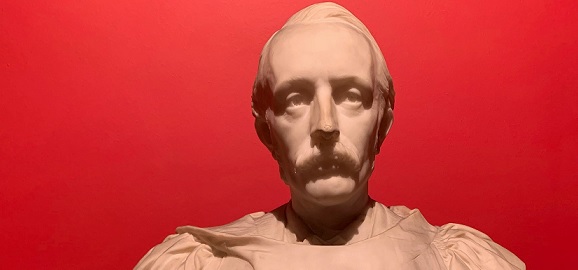
To celebrate International Sculpture Day we find out more about the bust of Principal Gerald Rendall that was unveiled 126 years ago on 20 February 1897.
Gerald Henry Rendall
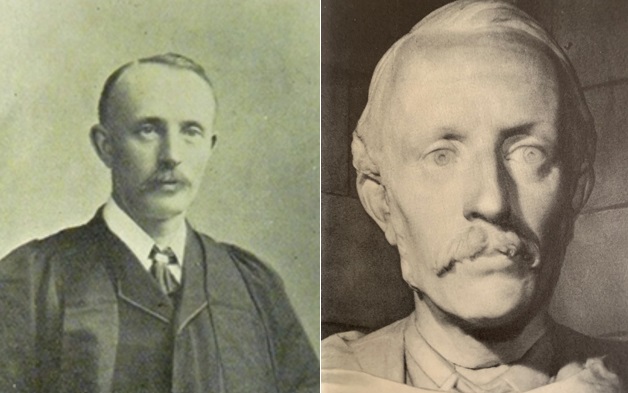
Left – Photograph of Gerald Rendall circa 1892, Right – The marble bust sculpted by C.J Allen in 1896.
The first Principal of University College Liverpool was Gerald Henry Rendall who served from 1881-1897.
In addition to the post of Principal, Rendall held the Gladstone Chair of Classics and Ancient History and was the Professor of Greek from 1880-97.
His most important publications were on early Christian authors writing during the Roman empire and on their late pagan opponents including Emperor Marcus Aurelius.
He married in 1887 and was presented with an illuminated manuscript from the students who praised him and all the work he had done for the college. At the bottom of the page is an illustration of the converted asylum that served as the first building for University College Liverpool and where Rendall worked for the first few years in Liverpool. It is one of only a few images of the old building to exist and it thanks to all of his personal paraphernalia that we can find out more about early life at University College Liverpool.
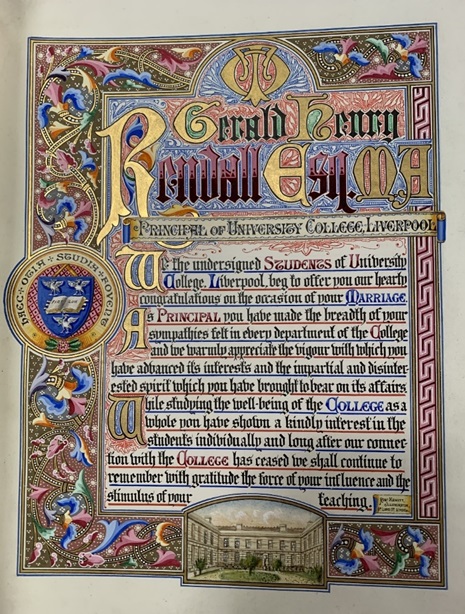
The illuminated manuscript presented to Rendall by the students in 1887. University of Liverpool Special Collections and Archives, S.3325
Principal Mottos
Having worked in the old building for several years, he provided valuable input into the design and function of the Victoria Building, working closely with Alfred Waterhouse to ensure the building was adequate for both its staff and students. He even designed some of the features in his own suite of offices including the fireplaces which include his own inspirational inscriptions.
The first inscription above his own personal fireplace was written in Greek and translates as: ‘It is the function of a king to do good and be slandered for it.’
It derives from the literary text ‘The Thoughts of the Emperor Marcus Aurelius Antoninus’ (Book 7: 36) and was a quote originally made by Philosopher Antisthenes of Athens.
Aurelius’ meditations are still considered a literary monument to a philosophy of service and duty and describes how to find and preserve composure in the midst of conflict by following nature as a source of guidance and inspiration.
Rendall presumably came across the quote whilst writing his academic publications about Marcus Aurelius and as the college principal, chose this as a personal motto for his own office – a reminder that no matter how good your intentions, there will always be criticism.
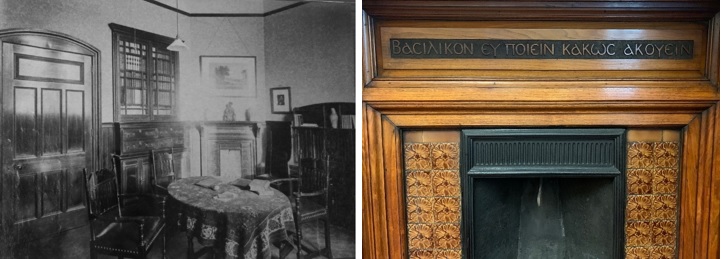
Left – the Principal’s Office circa 1892, Right – The- fireplace motto today.
In fact, in the speech that Rendall gave at the unveiling of his bust and a few months before he resigned as principal, he also echoed similar sentiments:
“There exist today and will exist, estrangements, jealousies and misunderstadnings among various powers and instruments – civic, religious, artistic and educational – tha contribute to the elevation of a great community such as this in which we work.
That reverses, mistakes and discouragements will take effect is, in the history of any great institution, inevitable.
It is too much to hope that Councils or Senates will always perfectly combine courage with prudence, zeal with caution, modesty with self-respect; that Principals will always be judicious; that students will always be infallible or impeccable. Take us at our best, in much we will be blind and erring. We are for the most part guessing imperfectly at the right answer.”
In his other office, the quote ‘To rule is to serve’ was the Latin inscription chosen above another fireplace in his suite of rooms and may have been another gentle reminder that as principal, his main job was to serve the wishes of the college.
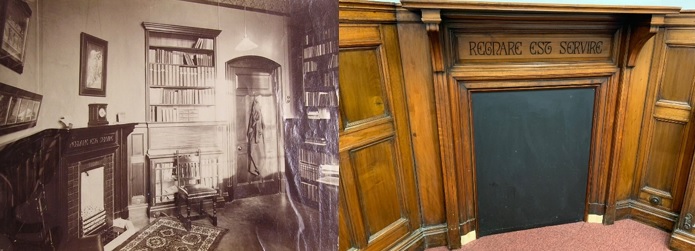
Left – Another of the Principal’s Offices circa 1892, Right – The- fireplace motto today.
Oppressed by administrative chores of both being Principal of University College Liverpool as well as Vice-Chancellor of the Victoria University, he was also at loggerheads with a few members of the Senate and longed to get back into teaching Greek again. A student prank at the Victoria Building opening ceremony also received quite a bit of attention in the press and so on the 14th December 1892, Rendall offered his resignation as principal.
However, the appointment of Vice-Principal MacCunn with the provision of secretarial assistance and the tightening up of student discipline kept him at Liverpool for a few more years until he decided to resign in December 1897.
The Bust
The unveiling of Rendall’s bust took place in the Tate Hall Library on 20 February 1897. The sculpture joined many other busts that adorned the centre aisle of the Tate Library.
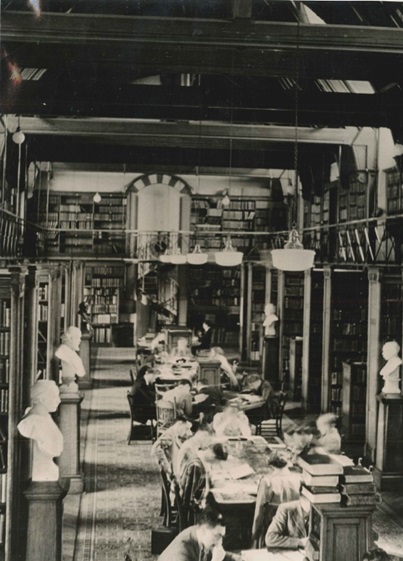
Tate Library circa 1930. Rendall’s bust is the closest to the camera on the left-hand side.
Lord Derby unveiled the bust and spoke at length to the progress of the college under the principalship of Rendall including the significant increase in professorships and student numbers and also the many buildings that had been constructed during the 15 years, including the Victoria Building. He noted the principal’s devotion and sense of justice in all that related to the administration of the college as well as his invaluable services as Professor of Greek.
Rendall humbly stated that it was a delicate and difficult task to respond publicly to speeches full of kind appreciation, but of the bust and its position in the Library he added:
“… there’s no place I would have chosen for a home as this Tate Library. It faces the Greek bay; whether after our disappearance, we may ever have power or opportunity to revisit old familiar haunts once cannot say, but if so, here if anywhere I should be found. My effigy will at least look upon the exteriors and backs of volumes which represent my own chosen studies and will day by day see college students passing in and out, perusing them for instruction and enjoyment. It is all that I could wish.
If some day, ten years hence or twenty or fifty it should seem right that this bust should be transferred to attic or basement - provided there have been found twelve bigger and better men to take their places at the end of these bookends for services rendered to this college.”
Although no longer presiding over the Greek section in the old Tate Library, the bust is on permanent display in Gallery Three on our first floor, 126 years after it was first unveiled. It is situated in a gallery space alongside handwritten class notes taken by one of his students Elizabeth Beckett and hand-written report cards from Rendall himself.
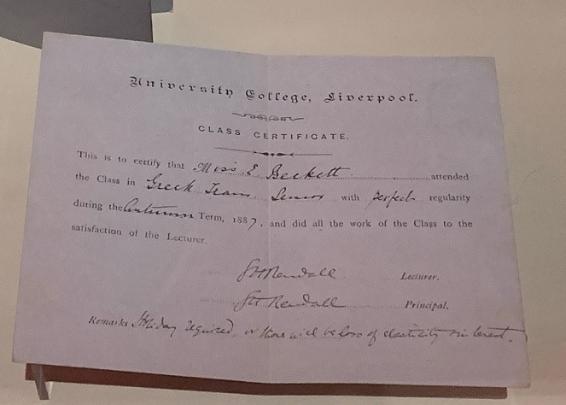
Elizabeth Beckett report card for Greek studies signed by Principal Rendall
The bust was sculpted by C. J. Allen and is a life size representation in marble and the wooden plinth was designed by Professor Simpson to match the style of other plinths in the library such as the one for William Rathbone VI. Henry Tate’s plinth is slightly different as the original position for this bust was outside the Tate Hall Library entrance as part of the Library block dedication.
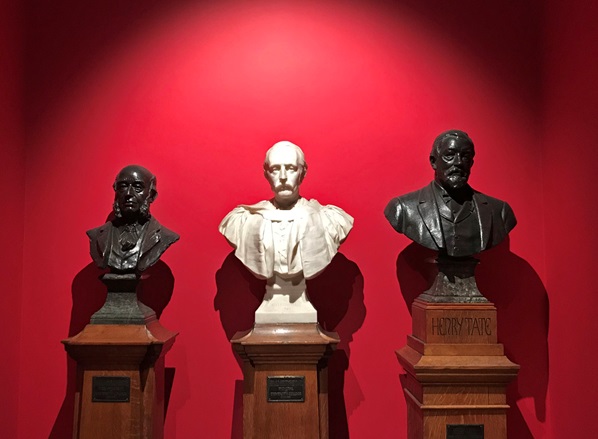
Busts on display in gallery three in the Victoria Building. Left – William Rathbone VI, Centre – Gerald Rendall, Right – Henry Tate.
To rule is to serve; it is the function of a King to do good.
When Rendall resigned he was also presented with a plaque signed by over 60 members of college staff that affirmed that he had fulfilled all the duties of his position from first to last and had never failed in word or deed.
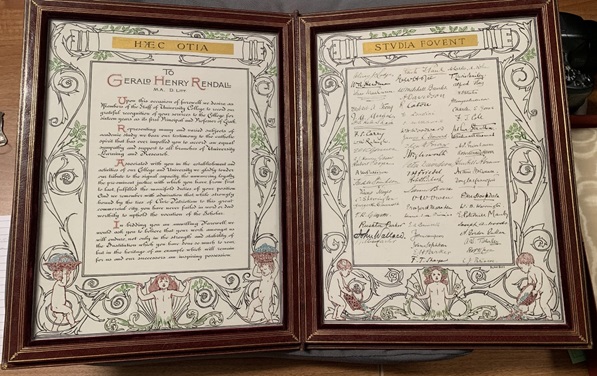
Testimonial from college staff on 6 May 1896, around the borders of the testimonial are water colour drawings of wingless cherubs and scrollwork by R. Anning Bell, who probably wrote the testimonial. Special Collections & Archives, S.3326.
The students also gave him a plaque and stated he had done everything to assist the students including the formation of the student councils, the advancement of the rightful claims of the female students and the encouragement of student societies.
Although there may have been some difficulties during his time as principal, the bust and plaques presented to him show that he was highly thought of and respected amongst both staff and students at the college.
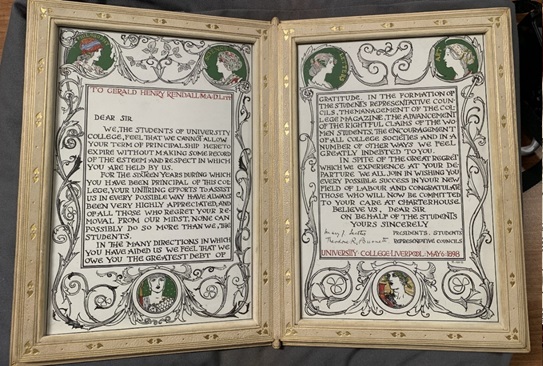
Testimonial presented to Rendall on 6 May 1898. Around the borders of the testimonial are water colour medallions of the heads of women depicting Philosophy and scrollwork, by R. Anning Bell who probably wrote the testimonial. Special Collections and Archives, S.3327
In his farewell address, Rendall humbly stated that he had “…served her (the college) perhaps mistakenly, but to the best of my ability.”
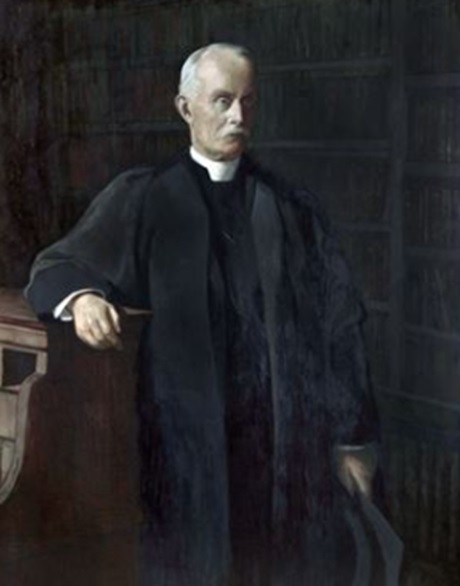
An oil painting of Gerald Rendall by The British School, Victoria Gallery & Museum.
Shortly after leaving the University, he was ordained, and on his retirement from Charterhouse in 1911, he settled in Dedham, Essex, where he became an honorary Canon of Chelmsford Cathedral and published a series of books on Shakespeare into his seventies.
In 1931, Rendall was invited back to the University of Liverpool for the Conferment of Honorary Degrees as part of the 50th anniversary celebrations of the foundation of University College Liverpool. Rendall’s role was to read the Roll of Benefactors in front of the congregation at St George’s Hall.
He died in 1945 aged 92, bequeathing to the Library the book collection he had built up in the course of his research on Marcus Aurelius. Special Collection and Archives also has a large collection of his personal material relating to the college including pamphlets, invitations to plays and the gifts he received over the years which help us to build up a picture of life at University College when it first began.
Today, you can see the bust as it watches over an exhibition all about the early days of University College Liverpool. It is situated next to two other great men; Henry Tate and William Rathbone VI and although he has now been repositioned in the building, we hope that Rendall’s wishes have still been fulfilled and he is still considered an important person in relation to services rendered to University of Liverpool history.
Keywords: Gerald Henry Rendall, International Sculpture Day, University College Liverpool, University of Liverpool , Sculpture, History.